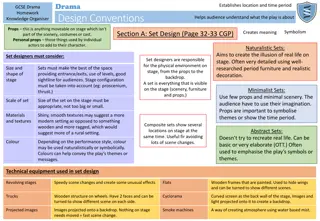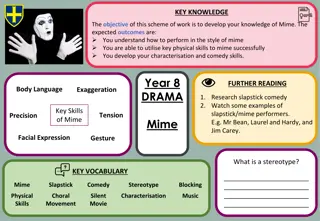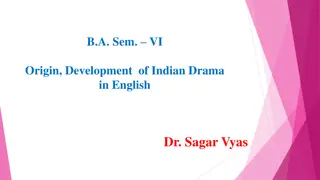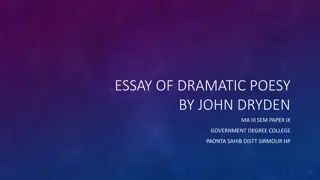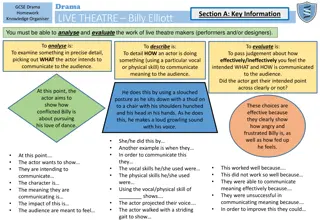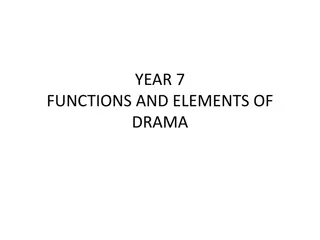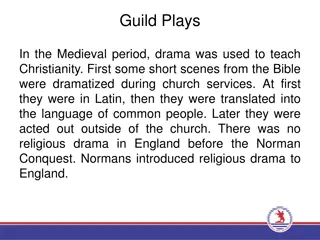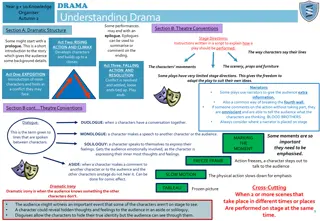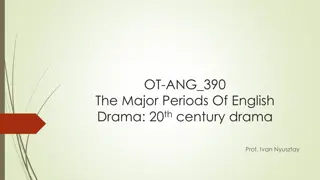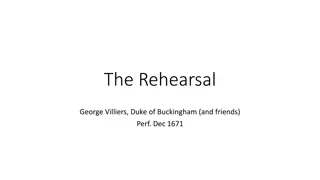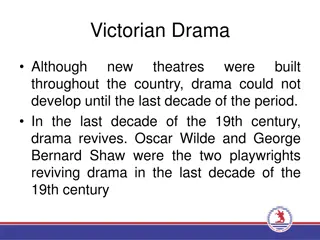Higher Drama Class of 2021 Overview
This overview provides information on the purpose and aims, skills, classwork, exams, attendance requirements, and developing complex drama skills in the Higher Drama Class of 2021. Candidates will develop practical drama skills, explore historical and cultural influences, and enhance production skills through practical examinations and written assessments. Attendance is crucial for performance opportunities and grade expectations.
Download Presentation

Please find below an Image/Link to download the presentation.
The content on the website is provided AS IS for your information and personal use only. It may not be sold, licensed, or shared on other websites without obtaining consent from the author. Download presentation by click this link. If you encounter any issues during the download, it is possible that the publisher has removed the file from their server.
E N D
Presentation Transcript
Welcome to Higher Drama Class of 2021
Purpose and Aims The course enables candidates to develop and use a range of complex drama skills and production skills. Candidates develop practical skills in creating and presenting drama, and knowledge and understanding of historical, social and cultural influences on drama. They analyse and evaluate how the use of self-expression, language and movement can develop their ideas for drama. They also develop critical-thinking skills as they investigate, develop and apply a range of complex drama skills and production skills. The course enables candidates to: generate and communicate thoughts and ideas when creating drama develop a knowledge and understanding of the historical, social and cultural influences on drama develop complex skills in presenting and analysing drama develop knowledge and understanding of complex production skills when presenting drama explore drama form, structure, genre and style 2
Skills, knowledge and understanding Skills, knowledge and understanding for the course The following provides a broad overview of the subject skills, knowledge and understanding developed in the course: responding to stimuli, including text, when creating drama working with others to share and use drama ideas developing knowledge and understanding of historical, social, cultural and theatrical influences when creating drama exploring drama form, structure, genre and style gaining knowledge and understanding of complex production skills applying complex drama and production skills when presenting applying evaluative skills within the creative process 3
Classwork, Exam & Attendance CLASSWORK: There are 2 main elements we will cover under classwork: 1. Development of drama skills: devising, group work, directing, acting. 2. Development of production skills: design based knowledge and understanding These will help prepare you for: 1. The final written examination 2. The final performance examination Development of Drama skills On-going assessment of acting and ability to use and devise characterisation activities Development of Production skills On-going assessment plus one final written assessment (based on Section 2 of exam paper) EXAM : practical examination (60% of overall grade - 50 marks for acting (2x 25 marks) OR 50 marks for design concept (30 = set design 20 = chosen design area)PLUS 10 mark pfp WHICH THE SQA EXAMINER AWARDS written examination - 2 hours 30 minutes (40%) ATTENDANCE: Unless it is 95% or above you cannot expect to act Unless it is 95% or above you cannot hope for an A or B 4
Developing Complex Drama Skills There are no longer units at Higher level however the following skills still apply You will: Apply complex drama skills by: 1. Responding to stimuli, including text, to develop ideas for drama. We will experiment with scenes from our set text in order to develop our knowledge and understanding as well as our acting skills Exploring form, genre, structure and style Developing and communicating ideas 2. 3. Contribute creatively to the drama by: 1. Planning to and either acting/designing or directing a scene from our set text as part of a group Using complex acting skills to portray character to an audience 2. 5
Developing Complex Production Skills The question paper is directly linked to these skills: we are preparing for possible questions through classwork You will: Explore complex production skills in drama by: 1. 2. Responding to stimuli, including text, to explore ideas for a production Selecting ideas for their chosen production roles You will: Apply complex production skills in drama by: 1. Developing appropriate ideas and production skills within their chosen production roles Demonstrating complex production skills within selected production roles for scenes from our set text e.g. how you would highlight theme through set design or character through costume 2. 6
Course assessment Structure and coverage of the Course assessment The Course assessment will consist of two Components a question paper The question paper will have three Sections. a performance. The performance will have two Sections the performance itself and the PFP Question paper The question paper will have 50 marks (40% of the total mark). The question paper has THREE Sections. Learners must answer SECTION 1 & SECTION 2 using THE SAME text with SECTION 3 being a different text. The question paper adds value by requiring integration and application of knowledge and skills from across course work. It allows learners to demonstrate their ability to interpret questions and respond in an informed way. 7
Course assessment: Performance This Component is worth 60 marks out of the total of 100 marks. The Course will be graded A D. This performance has two Sections. Section 1, titled performance will have 50 marks. Section 2, titled preparation for performance in the form of a review sheet will have 10 marks. This is the same at National 5 BUT THE VISITING ASSESSOR MARKS EVERYONE and it is for TWO characters or Design areas 8
Performance Exam- In this exam you are using a complex range of acting or directing or design skills Marks are awarded on the day by an SQA examiner The exam will be either directly before or directly after the Spring Break 60 marks 10 marks pfp 50 marks performance/design 9
Course Assessment- Preparation for performance (PFP) Section 1: preparation for performance 10 marks Candidates write about their preparation from the perspective of an actor or director or designer. In preparation for performance, marks will be allocated for: research into their chosen text(s) process (development and progression) of an acting or design concept So . You MUST: Provide an account of your research into your chosen text Reading play Finding facts about any circumstance related to your character in the play Watching anything related to your character in the play EXPLAIN your process Initial ideas What you did in the process (tasks) How your character developed intentions There is a limit of 500 words for this. 10% penalty for going over word count 10
Performance All candidates must demonstrate skills through two interactive acting roles from different plays: You will be awarded marks according to how effectively you: Communicate acting concepts by demonstrating an understanding of character through the use of textual clues Sustain character and convey relationships through credible interaction with other characters responding to themes and issues of the chosen text Use voice appropriately and effectively Use movement appropriately and effectively Create an impact on an audience developing characters and their relationships within the chosen text understanding the historical, social, cultural and theatrical context of their chosen text using a complex range of acting or directing or design skills communicating to an audience 11
Course Assessment- Performance Exam (acting) In the performance, marks will be allocated for: Acting: preparation and performance of two contrasting roles which must be selected from two different texts Actors: Actors should prepare two contrasting roles. 25 marks will be allocated for each role. Performances must involve interaction with at least one other .The performance of each acting role will last approximately seven to ten minutes. In each acting role the marks will be allocated according to how the candidate: communicates the agreed interpretation of acting concepts by demonstrating an understanding of character through textual clues sustains character and conveys relationships through credible interaction with other characters appropriate and effective use of voice appropriate and effective use of movement impact on audience The above areas will be allocated a maximum of 10 marks (a maximum of 5 marks for each of the two acting roles). 50 marks awarded 12
Course Assessment- Performance Exam (design) Designers design a set for their chosen text and choose one other relevant production role. For their additional production role, candidates must design for the whole play and there must be coherence with the set design. ONLY THOSE WHO HAVE EXCELLENT ARTISTIC AND ORGANISATIONAL SKILLS COULD BE CONSIDERED FOR A DESIGN Candidates must design a set for a specified performance space for the whole play text to include each act or scene and any significant change of setting. All acts or changes of location or setting must have a ground plan and elevation (end-on drawing) and they must create a coherent concept. The set does not need to be realised practically. Candidates present their work in a presentation lasting approximately 20 30 minutes. This must include the demonstration of their additional production role. For set design, candidates design a set and give a presentation. They must: evidence the development of their ideas from initial thoughts, research and designs to final design concept produce creative and effective design concepts in relation to requirements of the drama and needs of actors produce working and final designs and ground plans for the specified performance space including elevations, referring to textual clues Candidates must select one additional production role from: lighting, sound, props, costume, make-up and hair. The additional production role does not need to be demonstrated and assessed with the use of actors. For the selected additional production role candidates must: produce creative and effective notes/plotting sheets/plans/designs/cue sheets/drawings demonstrate practical skills in relation to their chosen production area 13
Course Assessment- Question Paper The written exam is 50 marks (40% of course award) 2 hours 2 x extended response questions (essays) 1 x structured response questions (short answers (?)- not seen any yet!) three sections: section 1: theatre production: text in context (extended-response questions) ANTIGONE section 2: theatre production: application (structured questions) ANTIGONE section 3: performance analysis (extended-response questions) SMALL ISLAND For sections 1 and 2, candidates must answer on their selected text. For section 3, candidates must answer on a performance they have seen using a different text from that used in sections 1 and 2. The question paper has 50 marks out of a total of 110 marks. This is scaled by SQA to represent 40% of the overall marks for the course assessment. 14
Course Assessment- Question Paper (SECTION 1) Section 1 (Antigone by Sophocles) theatre production: text in context 20 marks Candidates answer from the perspective of: an actor or director or designer in preparation for an intended production. Candidates analyse the selected text in the context of theatre production. They demonstrate knowledge of the selected text they have studied in terms of content and context, and show an understanding of how the text could be communicated to an audience through performance. Candidates gain credit for their ability to make use of appropriate structure, quotations and/or textual references. 15
Course Assessment- Question Paper (SECTION 2) Section 2 (Antigone by Sophocles) theatre production: application 10 marks Candidates answer structured questions on their understanding and application of two production roles for the selected text they have studied. Candidates respond on the ways in which two of the following production roles could be applied to their selected text: actor director designer To avoid predictability, two of the three production roles will be sampled each year. 16
Course Assessment- Question Paper (SECTION 3) Section 3 (LIVE theatrical performance: Likely the National Theatre s Small Island ) performance analysis 20 marks Candidates answer one extended-response question from a choice of two on a performance they have seen. The focus of the questions require candidates to respond on two of the following production areas: choice and use of the performance space director s intentions and effectiveness acting and development of characters design concepts and their effectiveness (it is not clear if the question will- like the old new higher be specific areas i.e. costume, lighting, set design, performance space etc. of whether a generic 2design will be used) The performance analysis may be of a live performance, a live-streamed performance, or, if necessary, a recorded live theatrical performance. Recorded performances must have been performed live within two years of the start of the academic year in which the assessment takes place. The performance must be a play, not a musical, pantomime or movement piece. Appropriate amateur performances may be used, providing candidates have the opportunity to meet the criteria for this section. Candidates MUST state the name of the performance in the introduction to their response. They MUST consider how the chosen production areas impacted on their appreciation of the performance. 17
Homework Course tasks Developing ideas Preparing for rehearsals Evaluations Reading plays Characterisation tasks Bringing necessary equipment Learning lines Planning and homework essays Learning quotes Preparing for assessments 18






